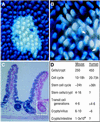Creating and maintaining the gastrointestinal ecosystem: what we know and need to know from gnotobiology
- PMID: 9841668
- PMCID: PMC98942
- DOI: 10.1128/MMBR.62.4.1157-1170.1998
Creating and maintaining the gastrointestinal ecosystem: what we know and need to know from gnotobiology
Abstract
Studying the cross talk between nonpathogenic organisms and their mammalian hosts represents an experimental challenge because these interactions are typically subtle and the microbial societies that associate with mammalian hosts are very complex and dynamic. A large, functionally stable, climax community of microbes is maintained in the murine and human gastrointestinal tracts. This open ecosystem exhibits not only regional differences in the composition of its microbiota but also regional differences in the differentiation programs of its epithelial cells and in the spatial distribution of its component immune cells. A key experimental strategy for determining whether "nonpathogenic" microorganisms actively create their own regional habitats in this ecosystem is to define cellular function in germ-free animals and then evaluate the effects of adding single or several microbial species. This review focuses on how gnotobiotics-the study of germ-free animals-has been and needs to be used to examine how the gastrointestinal ecosystem is created and maintained. Areas discussed include the generation of simplified ecosystems by using genetically manipulatable microbes and hosts to determine whether components of the microbiota actively regulate epithelial differentiation to create niches for themselves and for other organisms; the ways in which gnotobiology can help reveal collaborative interactions among the microbiota, epithelium, and mucosal immune system; and the ways in which gnotobiology is and will be useful for identifying host and microbial factors that define the continuum between nonpathogenic and pathogenic. A series of tests of microbial contributions to several pathologic states, using germ-free and ex-germ-free mice, are proposed.
Figures


References
-
- Adlerberth I, Carlsson B, de Man P, Jalil F, Khan S R, Larsson P, Mellander L, Svanborg C, Wold A E, Hansson L Å. Intestinal colonization of enterobacteriaceae in Pakistani and Swedish hospital delivered children. Acta Pediatr Scand. 1991;80:602–610. - PubMed
-
- Alam M, Midtvedt T, Uribe A. Differential cell kinetics in the ileum and colon of germ-free rats. Scand J Gastroenterol. 1994;29:445–451. - PubMed
-
- Al-Nafussi A I, Wright N A. Cell kinetics in the mouse small intestine during immediate postnatal life. Virchows Arch Cell Pathol. 1982;40:51–62. - PubMed
-
- Appelmelk B J, Negrini R, Moran A P, Kuipers E J. Molecular mimicry between Helicobacter pylori and the host. Trends Microbiol. 1997;5:70–73. - PubMed
-
- Appelmelk B J, Faller G, Claeys D, Kirchner T, Vandenbroucke-Grauls C M. Bugs on trial: the case of Helicobacter pylori and autoimmunity. Immunol Today. 1998;19:296–299. - PubMed
Publication types
MeSH terms
LinkOut - more resources
Full Text Sources
Other Literature Sources

